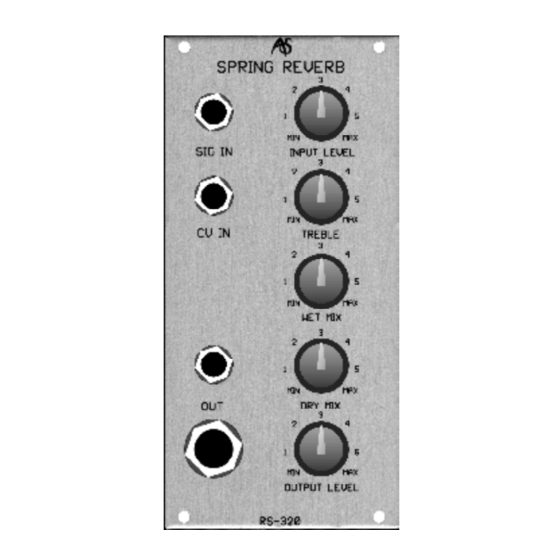
Advertisement
would be impossible without them, so you should approach the RS320 as another signal "modifier" - a
module that allows you to generate new sounds, rather than one that simply attempts to imitate a natural
effect. Furthermore, you can place the reverb within the signal chain of your synthesiser, thus using it as
part of the signal generation itself.
INSTALLATION
The RS320 comes in two parts: the front-panel module, and the spring/mounting tray itself. If these are
not pre-mounted in an Integrator case, you will need to install them yourself.
Firstly, you should inspect the plastic tray to ensure that it is completely flat, and that the spring unit
floats freely on its four mounting springs. If everything is in order, you must decide where you wish to
mount the unit inside your Integrator. Choose a suitable flat surface such as the inside of an RS15's side
or rear plates, and make sure that you avoid obstructions like the power supply.
If you inspect the tray closely you will see that it has two small clips - one at either end. These are not
designed for use with the Integrator, and you should remove them using a suitable tool such as a pair of
side-cutters. You should now make sure that you can stick the entire length of the tray to the chosen
mounting point, and that the transducer assemblies do not touch any part of the Integrator. Remove the
106
RS320
SPRING REVERB
INTRODUCTION
Reverberation is a phenomenon quite distinct from echo.
Whereas the latter may involve at most a handful of repeats
per second, a convincing reverb requires thousands per
second. Furthermore, these must not be regularly spaced, or
an unpleasant "ringing" sound will result. This means that
conventional analogue delay lines are quite unsuitable for
creating reverberant effects. A multi-tapped BBD such as the
RS310 can go some way to overcoming this, but even this is
incapable of creating realistic reverbs because it lacks the
sophisticated filtering and decay characteristics required.
Until the introduction of affordable digital signal processors,
studios used three methods to create reverberation. The first
was to place a speaker and one or more microphones in a
"live" room that possessed pleasing natural reverberation. The
second was to use a re verb "plate", a device that uses
transducers to excite - and then pick up the resulting vibrations
within - a large, heavy metal plate. The third is a cheaper
version of the plate. It is the "spring" reverb.
Of these, the live room (of course) produces the most authentic
reverb. A good quality plate is also very pleasing, but this is
due less to the authenticity of the reverb than to the tonal
quality it imparts. In contrast, the sound generated by a spring
is far from authentic, and it has proved unsuitable for many
natural sounds. Pass vocals, acoustic guitar, or percussion
through a spring rever b, and it simply goes "boinggg".
Nevertheless, spring reverbs are far from useless. Many guitar
amplifiers incorporate them, as do a handful of synthesisers.
The presence of these springs allows you to create sounds that
ANALOGUE SYSTEMS RS-INTEGRATOR
Advertisement
Table of Contents

Summary of Contents for ANALOGUE SYSTEMS RS320
- Page 1 The presence of these springs allows you to create sounds that would be impossible without them, so you should approach the RS320 as another signal "modifier" - a module that allows you to generate new sounds, rather than one that simply attempts to imitate a natural effect.
- Page 2 Integrator and the RS320 when you switch on the mains power. Note: The geometry of the RS320 is such that the power cable may "feel" natural the other way up. Do not let this confuse you.

Need help?
Do you have a question about the RS320 and is the answer not in the manual?
Questions and answers